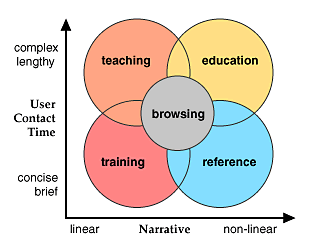| Planning your content outline |
| The content of a site is very closely related to the purpose of the site. There are basically four main possible purposes for an education-related website:
You should consider two main things when you write and arrange the information on the site (content). These are:
How long do you expect the user to remain on any one page in your site? Training and reference websites do not expect the user to remain for a long time on any one page. A school website is an information (reference) site. For this reason, you should not assume that users will spend a long time on your site. Your information should be brief and informative (referred to as 'concise/ brief' in the diagram below)
The tips section provided on this CD is an example of a training site. Sites like this require brief and clear information. If your site is meant to be educational (offer a wide range of experiences), or teach a concept, you will expect users to remain engaged by your site for longer, and your content will be more carefully structured (referred to as complex and lengthy in the diagram). The trigonometry site is an example of this. Narrative refers to the way in which you present the information on your site in writing. It involves the story that you tell to the readers as they progress through your website. It is also the way in which you transport the readers through your website. There are two ways of presenting information on a website. Linear (see diagram above). This is like reading a book. You start at one point and keep turning the page until you reach the end. Look at this Aids and beliefs website, as an example of a linear site. Unfortunately, in this example, this is not the best way to produce the information. The Understanding section of the trigonometry site, however, teaches about Trigonometry and therefore takes you through a linear explanation in 5 pages. Notice the use of next and back / previous buttons. A Non-linear approach This is where a reader can follow a number of options on any one page. Different readers may therefore explore completely different areas of content on the site, by clicking on different links in a different order. The Neurocentricity website is a good example of an educational site that is non-linear. The Trigonometry site also has a non-linear option (the menu on the left of that Web page). In all of the examples you've seen, you will have noticed how the content of the websites is divided up into several pages, each with small and manageable amounts of content. Note that the text is easier to read if your sentences and paragraphs are short and to the point.
|
